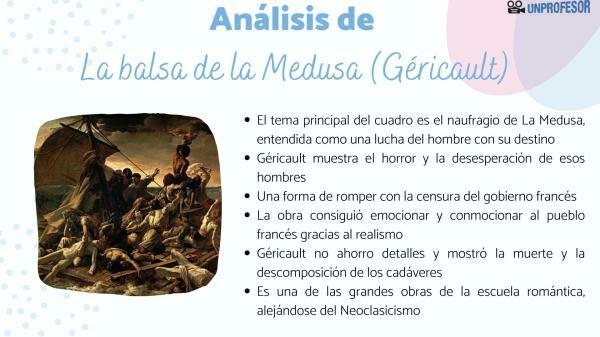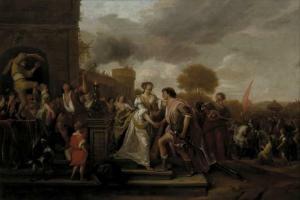Characteristics of Géricault's The Raft of the Medusa

The Raft of the MedusaIt is a painting that marks the start of French Romanticism, as well as being a work with a contemporary and most controversial theme. the author of it, Gericault (Rouen, 1791-Paris, 1824), exhibited the work in 1819 at the Louvre Museum and managed to shock the public with the drama and macabre realism that he imprinted on the scene. A true story that managed to overcome censorship and made The Raft of the Medusa considered a masterpiece.
In this lesson of unPROFESOR.com we tell you all the characteristics of The Raft of the Medusa and the story behind this impressive work.
The Raft of the Medusa is an oil on large size canvas, reaching dimensions of 490x717 centimeters. It is exhibited in the Louvre as one of his most outstanding works.
Here we are going to discover what are the main features of The Raft of the Medusa from Gericault:
- The main theme of the painting is the shipwreck of the Medusa, a French ship sunk three years earlier. The captain's negligence had brought about the death of a large part of the crew, saving only the wealthiest and most influential. The others had been left to their fate on that raft.
- Géricault acts as a modern painter and uses his art to show the general public the horror and despair of those men, women and children on such a fragile raft. A way to break with the censorship of the French government and show the magnitude of the tragedy.
- The work got excite and shock to the French people thanks to the realism that Géricault managed to capture on stage.
- Gericault spared no details and showed the death and decomposition of the corpses, being one of the most shocking stories about the character of the painter the one that tells us how the painter took heads and parts of bodies from the morgue to his study.
- The main theme of the work is the tragedy understood as a man's struggle with his destiny. In the painting, destiny is represented by the forces of nature, making it impossible to fight against them, since man is doomed to failure.

Once seen the characteristics of The Raft of the Medusa more general, we are going to attend to the technical aspects of this work. They are the following:
- The Raft of the Medusa is a large oil on canvas in which the composition is built on a diagonal axis that goes from one of the corpses to the shirt that flutters in the wind in the hand of one of the survivors who tries to attract the attention of another of the ships of the expedition. This diagonal crosses another diagonal that crosses the painting from one of the corpses on the right to the sail of the raft. A cross-shaped composition It brings dynamism and drama to the scene.
- A dynamism that is also marked by the way of linking the postures of the different characters that are located on the raft. This composition is inspired by the Rubens' baroque compositions either caravaggio.
- The influence of the latter in terms of color is also notable. In The Raft of the Medusa, warm tones such as browns or reddish tones predominate, in addition to using strong light and areas of chiaroscuro reminiscent of the caravaggio tenebrism. An ideal resource to create a dramatic atmosphere. In the foreground are corpses and survivors seeking help and hoping for rescue, while in the background the evening light appears.
- the whole scene is depicted from a high point of view that allows the painter to offer us the faces and expressions of the shipwrecked. The horizon line is also represented very high, contributing to further highlight the feeling of tragedy.
- Another outstanding feature of the work is a marked realism and the use of foreshortenings as a way of making the emotional part of the work more intense. In addition, Géricault shows great knowledge of human anatomy, an aspect that he learned both from nature and from great masters such as Michelangelo, Tintoretto or Caravaggio.
- The Raft of the Medusa is one of the great works of the romantic school, moving away from Neoclassicism and being a model for the works of other great figures of the movement such as Delacroix, The influence of artists such as Rubens, Velázquez or Veronés is also notable. Freedom, emotion and individuality are the values that can be admired in this work. Values that marked the entire romantic era.



